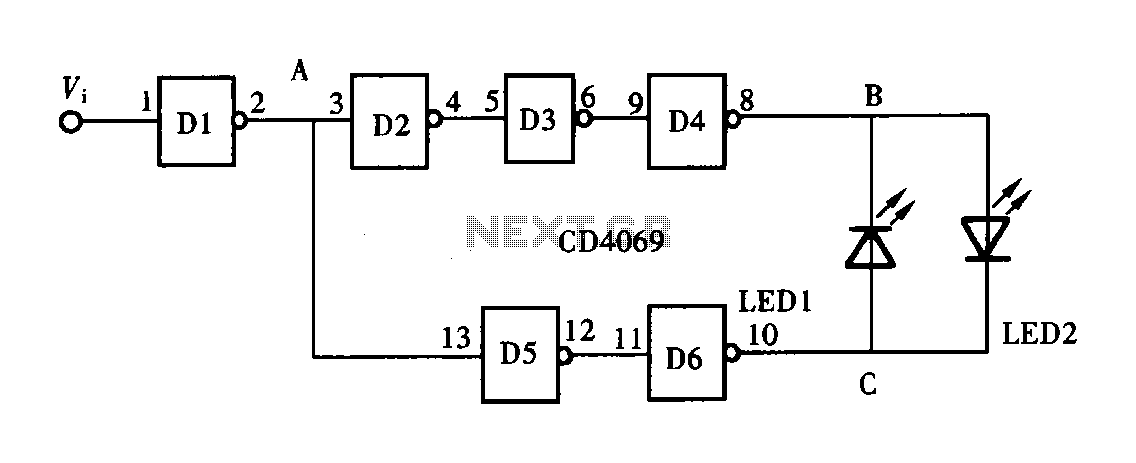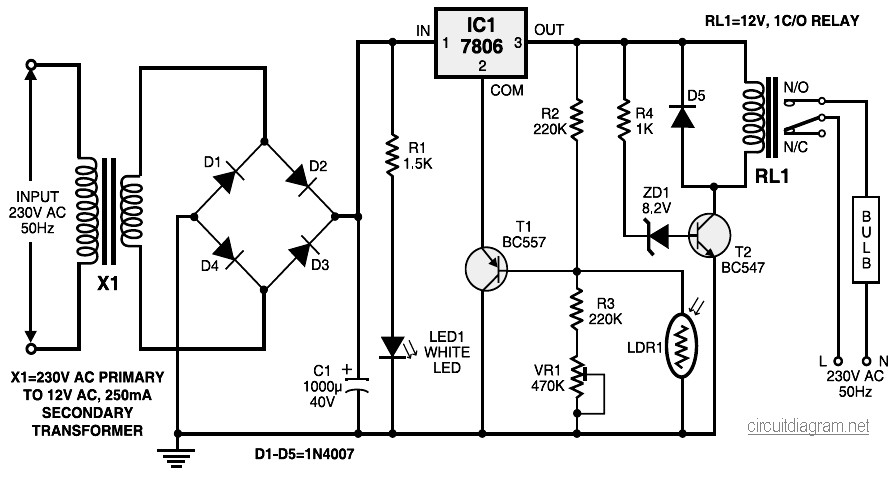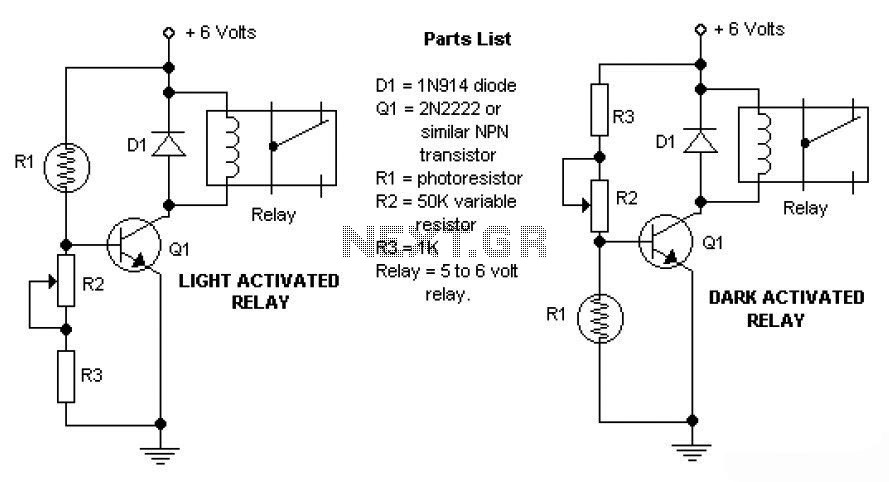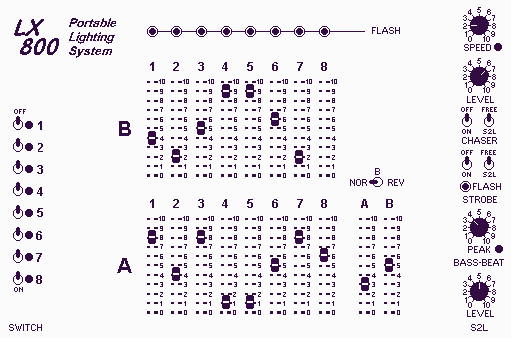
mini light
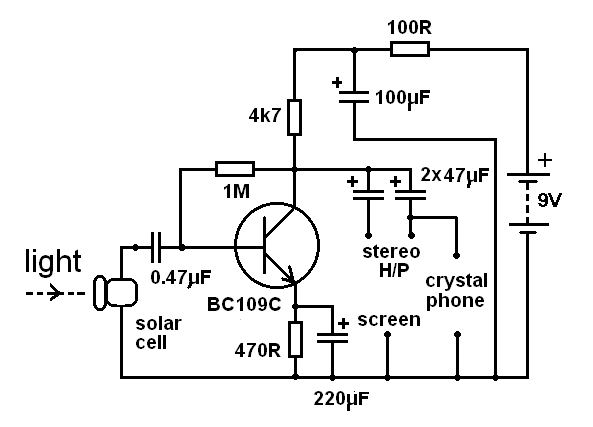
The handheld mini light beam receiver features a small solar cell on the left side, with various components visible on the circuit board through a transparent lid. On the right side, there are sockets for headphones and a crystal earpiece located at the top and bottom, while the battery is slightly visible in its holder at the back (far right). The battery connector can be unplugged to turn off the device. This simple device converts light into sound by connecting a solar cell directly to headphones or an earpiece. The solar cell generates electricity from light, which the headphones then convert into sound. However, this basic setup is quite insensitive. A more sensitive circuit incorporates a transistor amplifier that provides approximately 100 times amplification. This circuit serves as one of the simplest starting points for effectively listening to light. It functions as a basic preamplifier stage, which can be used before a pair of computer speakers. The circuit can power a crystal earpiece and, with some reduction in volume, stereo Walkman MP3-type headphones directly. Since only the AC component of the signal passes through the transistor, the orientation of the solar cell does not affect the circuit. With just a few components and a battery, users can begin to explore the world anew with this device, enabling them to hear what they previously could only see. Suggested experiments include: 1) Finding a room with loud music playing and then observing sunlight reflected from a window or using a torch/laser to listen to the light. 3) Listening to dappled light from trees or the changing surface of water. 4) Using a prism to break sunlight into a spectrum of colors and listening to the infrared and ultraviolet parts, as well as the visible spectrum. 5) Experimenting with a laser pointer for greater distances and comparing sound quality. 8) Utilizing binoculars, using one eye for the photocell and the other for viewing, to know what is being listened to. 17) Using yellow glasses, which improve visibility through haze, to determine the optimal color light for sending a light beam signal.
The handheld mini light beam receiver is a compact device designed to convert light into sound, utilizing a solar cell as its primary sensor. The solar cell, positioned on the left side of the device, captures ambient light and converts it into electrical energy. This energy is then transmitted to headphones or a crystal earpiece, which transduce the electrical signals into audible sound. The basic configuration, while functional, is limited in sensitivity, prompting the integration of a transistor amplifier into the circuit.
The transistor amplifier significantly enhances the output signal, providing approximately 100 times amplification, which is crucial for effectively detecting and converting light signals into sound. This makes the device suitable for various applications, such as experimental audio exploration. The circuit design is straightforward, incorporating a few essential components: the solar cell, the transistor amplifier, and the output sockets for headphones or earpieces.
The circuit's design allows for flexibility in wiring, as it only processes the AC component of the signal. This means that the solar cell can be connected in either orientation without affecting performance. The integration of a battery provides portability, allowing users to take the device outside for practical experiments.
Users can engage in various activities to explore the device's capabilities. For instance, when in proximity to a loud music source, one can observe sunlight reflecting off surfaces and listen to the corresponding sound produced by the light. Observing natural phenomena, such as dappled sunlight filtering through leaves or the shimmering surface of water, can yield fascinating auditory experiences.
Using a prism to separate sunlight into its constituent colors presents an opportunity to explore the auditory effects of different wavelengths, including infrared and ultraviolet light. Experimentation with laser pointers may further enhance the range and quality of sound produced, allowing users to experiment with distance and reflection off various surfaces.
Incorporating binoculars into the experience can facilitate a dual observation and listening approach, enhancing the user's engagement with the environment. Additionally, using tinted yellow glasses can improve visibility in hazy conditions, allowing for a clearer perception of light signals. Overall, the handheld mini light beam receiver serves as an innovative tool for auditory exploration, merging the realms of light and sound in a unique and interactive manner.The handheld mini light beam receiver. On the left is a small solar cell, you can make out the various components on the circuit board through the transparent lid of the box. On the right, top and bottom, are the headphone and crystal earpiece sockets while the battery is just visible in its holder at the back (far right).
I simply unplug the batt ery connector to turn the unit off. A very simple device to convert light into sound can be made by wiring a solar cell directly to headphones (or an earpiece). The solar cell converts light into electricity and the headphones convert electricity into sound. The limitation is that this set-up is very insensitive. What follows is a far more sensitive circuit as it contains a transistor amplifier which provides about x100 amplification.
The circuit must rate as the simplest starting point to effectively listen to light! We have made what is effectively a simple preamplifier stage which for example can go before a pair of computer speakers. The circuit is capable of powering a crystal earpiece and (with some loss of volume) stereo walkman MP3 type headphones directly.
As only the AC part of the signal goes through to the transistor it does not matter which way round you wire in the solar cell. So with just a handful of components and a battery you can start to re-explore the world with this little device - to hear what you have up to now only seen!
1) find a room with loud music playing (or orchestra playing) and when outside look out for sunlight reflected from one of the windows (or use torch / laser) and listen to the light - can you hear the orchestra on the light !. 3) listen to the dappled light from trees or from the ever changing surface of the sea / lake. Try listening to light shinning through a fan / extractor or other rotating device. 4) use a prism to brake up sunlight into the rainbow of colours. Listen to the IR and UV parts as well as the visible parts of the light in these experiments. 5) experiment with a laser pointer. You might get greater distances but is the sound better quality or worse, why Try reflecting off all sorts of objects.
8) if you use binoculars you can use one `eye` for the photocell and one for you to look through - you know what you are looking at when you listening to it! 17) yellow glasses are used by cyclists and adventurers as they see through haze better than normal clear glasses or sun glasses (once the eyes have adjusted to the new light levels).
What colour light is best to send a light beam signal 🔗 External reference
The handheld mini light beam receiver is a compact device designed to convert light into sound, utilizing a solar cell as its primary sensor. The solar cell, positioned on the left side of the device, captures ambient light and converts it into electrical energy. This energy is then transmitted to headphones or a crystal earpiece, which transduce the electrical signals into audible sound. The basic configuration, while functional, is limited in sensitivity, prompting the integration of a transistor amplifier into the circuit.
The transistor amplifier significantly enhances the output signal, providing approximately 100 times amplification, which is crucial for effectively detecting and converting light signals into sound. This makes the device suitable for various applications, such as experimental audio exploration. The circuit design is straightforward, incorporating a few essential components: the solar cell, the transistor amplifier, and the output sockets for headphones or earpieces.
The circuit's design allows for flexibility in wiring, as it only processes the AC component of the signal. This means that the solar cell can be connected in either orientation without affecting performance. The integration of a battery provides portability, allowing users to take the device outside for practical experiments.
Users can engage in various activities to explore the device's capabilities. For instance, when in proximity to a loud music source, one can observe sunlight reflecting off surfaces and listen to the corresponding sound produced by the light. Observing natural phenomena, such as dappled sunlight filtering through leaves or the shimmering surface of water, can yield fascinating auditory experiences.
Using a prism to separate sunlight into its constituent colors presents an opportunity to explore the auditory effects of different wavelengths, including infrared and ultraviolet light. Experimentation with laser pointers may further enhance the range and quality of sound produced, allowing users to experiment with distance and reflection off various surfaces.
Incorporating binoculars into the experience can facilitate a dual observation and listening approach, enhancing the user's engagement with the environment. Additionally, using tinted yellow glasses can improve visibility in hazy conditions, allowing for a clearer perception of light signals. Overall, the handheld mini light beam receiver serves as an innovative tool for auditory exploration, merging the realms of light and sound in a unique and interactive manner.The handheld mini light beam receiver. On the left is a small solar cell, you can make out the various components on the circuit board through the transparent lid of the box. On the right, top and bottom, are the headphone and crystal earpiece sockets while the battery is just visible in its holder at the back (far right).
I simply unplug the batt ery connector to turn the unit off. A very simple device to convert light into sound can be made by wiring a solar cell directly to headphones (or an earpiece). The solar cell converts light into electricity and the headphones convert electricity into sound. The limitation is that this set-up is very insensitive. What follows is a far more sensitive circuit as it contains a transistor amplifier which provides about x100 amplification.
The circuit must rate as the simplest starting point to effectively listen to light! We have made what is effectively a simple preamplifier stage which for example can go before a pair of computer speakers. The circuit is capable of powering a crystal earpiece and (with some loss of volume) stereo walkman MP3 type headphones directly.
As only the AC part of the signal goes through to the transistor it does not matter which way round you wire in the solar cell. So with just a handful of components and a battery you can start to re-explore the world with this little device - to hear what you have up to now only seen!
1) find a room with loud music playing (or orchestra playing) and when outside look out for sunlight reflected from one of the windows (or use torch / laser) and listen to the light - can you hear the orchestra on the light !. 3) listen to the dappled light from trees or from the ever changing surface of the sea / lake. Try listening to light shinning through a fan / extractor or other rotating device. 4) use a prism to brake up sunlight into the rainbow of colours. Listen to the IR and UV parts as well as the visible parts of the light in these experiments. 5) experiment with a laser pointer. You might get greater distances but is the sound better quality or worse, why Try reflecting off all sorts of objects.
8) if you use binoculars you can use one `eye` for the photocell and one for you to look through - you know what you are looking at when you listening to it! 17) yellow glasses are used by cyclists and adventurers as they see through haze better than normal clear glasses or sun glasses (once the eyes have adjusted to the new light levels).
What colour light is best to send a light beam signal 🔗 External reference
